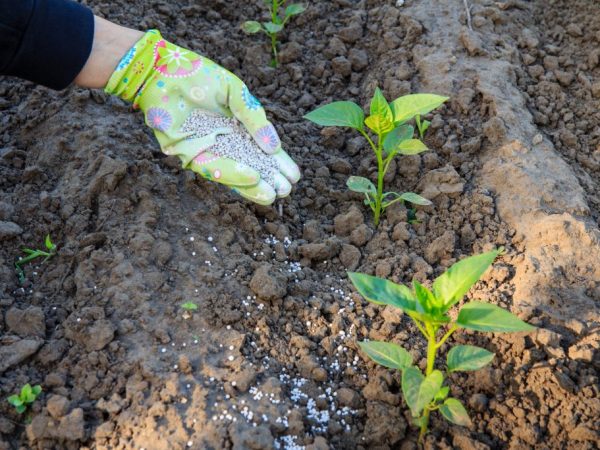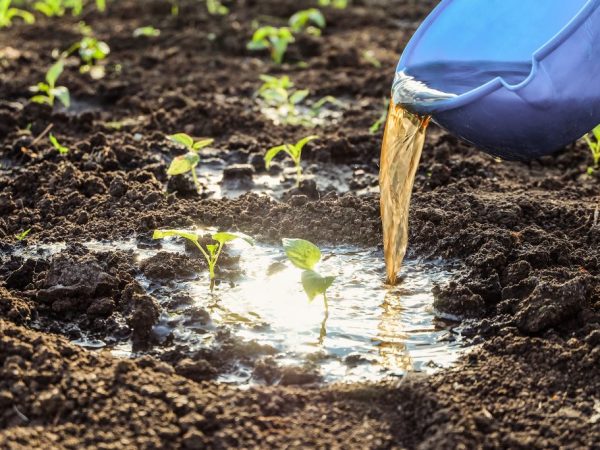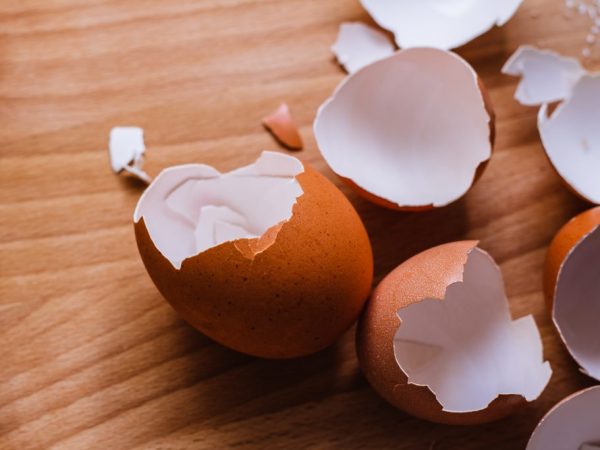Rules for feeding pepper in the open field
Top dressing of pepper in the ground is the key to high yields. According to some signs, it is possible to determine what trace elements the plant lacks. It is important to alternate foliar and root feeding.

Rules for feeding pepper in the open field
Fertilizer shortage signs
The main signs are:
- Slowing down the growth of a bush or seedling. The sprout weakens, becomes lethargic. The color turns from bright to pale. Leaves wilt or fall off.
- The stem of the plant does not fully develop. Its growth is very weak. The second option is that it began to turn yellow, which indicates a small amount of nitrogen.
- The vegetative part becomes dull. A "marginal burn" appears at the tips of the leaves. The leaf plate turns pale, becomes wrinkled. The leaves are deformed, curled. These are clear signs of potassium deficiency.
- A purple-hued vegetable culture indicates a lack of phosphorus. Other signs of a deficiency of this trace element are the bronze tint of the leaves. Red spots may appear near the stem, which can turn purple.
- Falling leaves and ovaries are a sign of calcium deficiency. New kidneys cease to form. The already formed leaves curl and die off.
The appearance of apical rot on the fruits indicates that the plant lacks calcium or its complete absence. If the leaves are small or begin to deform, this is a sign that micronutrient fertilization needs to be applied.
Feeding rules
Seedlings are usually planted in the garden after 75-80 days. The height should be about 20 cm. The pepper does not tolerate transplanting very well. Therefore, the first top dressing for pepper in the open field is very important.
The vegetation of a vegetable, and especially its intensity, directly depends on the quality of the soil in which the plant was planted. Accordingly, the poorer the soil, the more compensation should be for the lack of nutrients that the bushes need.
It is best to feed a vegetable using drip irrigation. In this way, fertilizers are absorbed much more efficiently.
Timely feeding is very important for the full development of a fruitful plant - they help to strengthen it. It is desirable to feed the pepper after planting in the ground 10-14 days after the appearance of the first 2-3 leaves.
Feeding methods
There are several ways of feeding - root and foliar. Foliar are used before the buds appear and are produced by pollination with aqueous solutions. Root feeding of pepper in the open field consists of several stages:
- When planting seeds;
- Primary application when transplanting into open ground;
- During flowering to fruiting;
- During fruiting.
It is important to feed the peppers after planting in the ground in several stages.
First step

Plant feeding is carried out in several stages.
It is carried out 15 days after planting a vegetable crop in open ground. Use 2 tbsp. spoons of urea and 2.5 tbsp. tablespoons of superphosphate.Both components are mixed in 1 bucket of water (about 10 liters of water). For each bush, you need at least 1 liter of solution.
Second phase
It is carried out during the flowering period. To prepare the solution, you will need 1 teaspoon of carbamide, potassium and 2 tbsp. tablespoons of superphosphate. All components are mixed and diluted in 10 liters of water. To feed 1 plant, 1 liter of solution is needed.
Stage Three
The last stage is carried out during the period when the first fruits appear. The solution is prepared on the basis of the following components:
- 2 teaspoons of potassium salt;
- 2 teaspoons of superphosphate;
- 10 liters of water.
For watering, take 1-2 liters of solution. It is applied either as foliar feeding, or by drip irrigation.
After each top dressing, it is important to loosen. Do this as carefully as possible. Because the roots are close to the ground and can be easily damaged.
Fertilizers
Top dressing is applied using organic and mineral fertilizers. They can be used singly or in combination.
Mineral (chemical)
For fertilizing in the open field, water-soluble fertilizers are used - they are better absorbed. To prevent the appearance of various diseases, including rot, calcium nitrate is used throughout the growth of the plant. The solution is made at the rate of 10 liters per 10 acres. This procedure is carried out about 5-7 times.
Before the buds appear on the sprout, it is recommended to fertilize with nitrogen fertilizers. They contribute to the development of the plant, the strengthening of the shoots and the laying of new fruits.
In the fertile period, it is necessary to apply potash and phosphate fertilizers. With phosphorus starvation, you need to add superphosphate. You will need 50 g per 10 liters of water. This amount is enough for 10 bushes.
With a lack of potassium, feeding is carried out on the basis of sodium chloride. It is necessary to take 100 g of the substance and dilute it in 10 liters of water. For foliar dressing, you will need 2 times less.
Natural (organic)

Organic fertilizers include eggshells
The main advantages of organic fertilizers are cheapness and naturalness. The most popular natural feeding products are:
- coffee grounds;
- banana peel;
- eggshells;
- potato peelings;
- infusion of nettle.
The most common are manure, bird droppings. On their basis, an aqueous infusion is made, which is used for watering. Mullein is bred in a ratio of 1 to 4, and bird droppings are bred 1 in 10.
Another recipe - 1 kg of manure and 0.5 kg of bird droppings are soaked in a bucket of water for 5-7 days. The prepared solution is taken at the rate of 1 liter per 1 m2 of land.
Another popular substance is ash. These are non-combustible wood residues. Usually used for foliar feeding.
Such fertilizers have a good effect on the sprouts. After using them, the leaves turn a rich green color. This feeding also has a very beneficial effect on the development of the plant's root system.
Combined feeding
This is the most effective way to replenish the stocks of beneficial micronutrients in vegetable crops. Often, at the first feeding, urea with potassium or sodium humate is used. Dissolve in water.
During subsequent fertilization, urea and potassium monophosphate are also dissolved in water. Watering is carried out carefully, without affecting the entire plant, only at the root.
Other common combinations of organic and mineral fertilizers:
- 40 g of superphosphate, 15 g of potassium chloride, 150 g of wood ash per 10 liters of water;
- 15 g of ammonium nitrate, 60 g of potassium chloride, 20 g of wood ash per 1 bucket of water;
- 0.5 kg of manure, 250 g of poultry droppings, 1 tbsp. spoon of potassium monophosphate in 8 liters of water.
Each combination is designed for 8-10 plants. This number of bushes is enough for 10 liters of solution. You need to feed it 1-2 times a week.
Recommendations
In order for the pepper seedlings to grow well, root and foliar feeding is carried out alternately. It is advisable to feed the plant once a week. For the entire time of the growth of the bushes, you need to do foliar feeding at least several times.Manure is applied under the previous crop, so that due to the growth of stems and leaves, it does not damage fruiting.
For planting, you can use a container made of milk or sour cream, in advance, having made small holes in the bottom. In the process, the soil must be mixed with humus. So the sprouts will safely transfer the planting into open ground and will be able to do without feeding for more time.
Fertilizers need to be added exclusively to the root, and if the fertilizing accidentally fell on the leaves, then it is imperative to rinse it off. Otherwise, it will burn out the leaves, which can negatively affect fruiting.
Do not forget that fertilizers must be diluted in warm water. The temperature of the finished product should not exceed 22-24 ° C.
Pay attention to the weather conditions at the time of feeding. So, as in cloudy and cool times, this culture needs 20% more potassium than in warm weather, especially in summer.
Conclusion
Top dressing of peppers in the open field is an important step in growing a plant. It is advisable to carry out complex healing, consisting of mineral and organic fertilizers. The main purpose of top dressing is to improve the growth of bushes, increase plant immunity and help the pepper take root in the open field.


